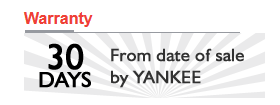* Reamer & Drill Selection Procedures
View printable version of this page Selecting the correct reamer diameter is not quite as simple as one might think. Selecting the correct drill size is also important as doing so will prolong the life of your reamer and ensure proper size and finish. There are 3 steps involved in selecting the correct Yankee reamer and drill size for your application:
1) Determine the correct Yankee reamer diameter based on total hole tolerance and the machineability of your material.
2) Calculate the correct hole diameter needed prior to reaming,
3) Select the proper drill diameter to make that hole.
An example follows each step.
Step #1:
To calculate the correct Yankee reamer diameter, based on the machineability of the material to be reamed, deduct the allowances in the following table from the maximum finished hole size:
For example: If your finished hole size is .5000 with a -.0005 +.0000 tolerance, and the material is 302 Stainless (which has a machineability rating of 50) the chart shows that the range to deduct is. 0004-.0005.
.5000 -.0004 = .4996
.5000 -.0005 = .4995
Therefore, the best Yankee reamer size is .4995
| Machineability | Rating | |
|---|---|---|
| Total Hole Tol. | 30 or Less or Above 100 | 31-100 |
| .0005″ | .0003-.0004 | .0004-.0005 |
| .0010 | .0004-.0006 | .0006-.0008 |
| .0015 | .0005-.0008 | .0008-.0010 |
| .0020 | .0006-.0010 | .0010-.0014 |
| .0030 | .0009-.0020 | .0009-.0020 |
| .0040 | .0012-.0026 | .0012-.0026 |
| .0050 | .0014-.0032 | .0014-.0032 |
| .0060 | .0017-.0038 | .0017-.0038 |
| .0070 | .0019-.0044 | .0019-.0044 |
| .0080 | .0022-.0050 | .0022-.0050 |
| .0090 | .0024-.0056 | .0024-.0056 |
| .0100 | .0027-.0062 | .0027-.0062 |
Step #2:
Based on the Yankee reamer selected in step # 1, the following table shows the amount of stock that should be removed by the reamer (leaving the recommended amount will ensure the best finish and tolerance):
Using the same example (finished hole size is .5000 with a -.0005 +.0000 tolerance, and the material is 302 Stainless (which has a machineability rating of 50): the chart shows that the amount to deduct from the Yankee reamer size is .007-.015.
4995 -.015 = .4845
4995 -.007 = .4925
Therefore, the best hole size before reaming is between .4845 and .4925
| Machineability | Rating | |
|---|---|---|
| Diameter Range | 30 or Less | 31 and Up |
| .0000-.0625 | .006-.010 | .003-.005 |
| .0626-.1250 | .006-.010 | .004-.007 |
| .1251-.2500 | .006-.010 | .005-.010 |
| .2501-.5000 | .012-.020 | .007-.015 |
| .5001-1.0000 | .012-.020 | .010-.020 |
Step #3:
Based on the pre-reaming hole diameter selected in step # 2, the following table shows the oversize allowance that should be deducted from the hole size to arrive at the correct drill size:
Using the same example (pre-reaming hole size is between .4845 and .4925 and the material is 302 Stainless (which has a machineability rating of 50): the chart shows that the amount to deduct from the Yankee reamer size is .0048.
4845 -.0048 = .4797
4925 -.0048 = .4877
Therefore, the best practical drill size is 31/64 (.4844) because it is between .4797 and .4877 To recap: in this example you should use a 31/64 drill and a .4995 Yankee reamer.
| Machineability | Rating | |
|---|---|---|
| Diameter Range | 30 or Less or Above 100 | 31-100 |
| .0000-.0625 | .0005 | .0015 |
| .0626-.1250 | .0006 | .0028 |
| .1251-.1875 | .0008 | .0036 |
| .1876-.2500 | .0008 | .0042 |
| .2501-.5000 | .0010 | .0048 |
| .5001-.7500 | .0012 | .0052 |
| .7501-1.0000 | .0020 | .0065 |
Please note: All information contained in these pages is accurate to the best of our knowledge. Materials and conditions can vary, causing differences over which we have no control. Therefore, we cannot accept responsibility for your particular situation.



